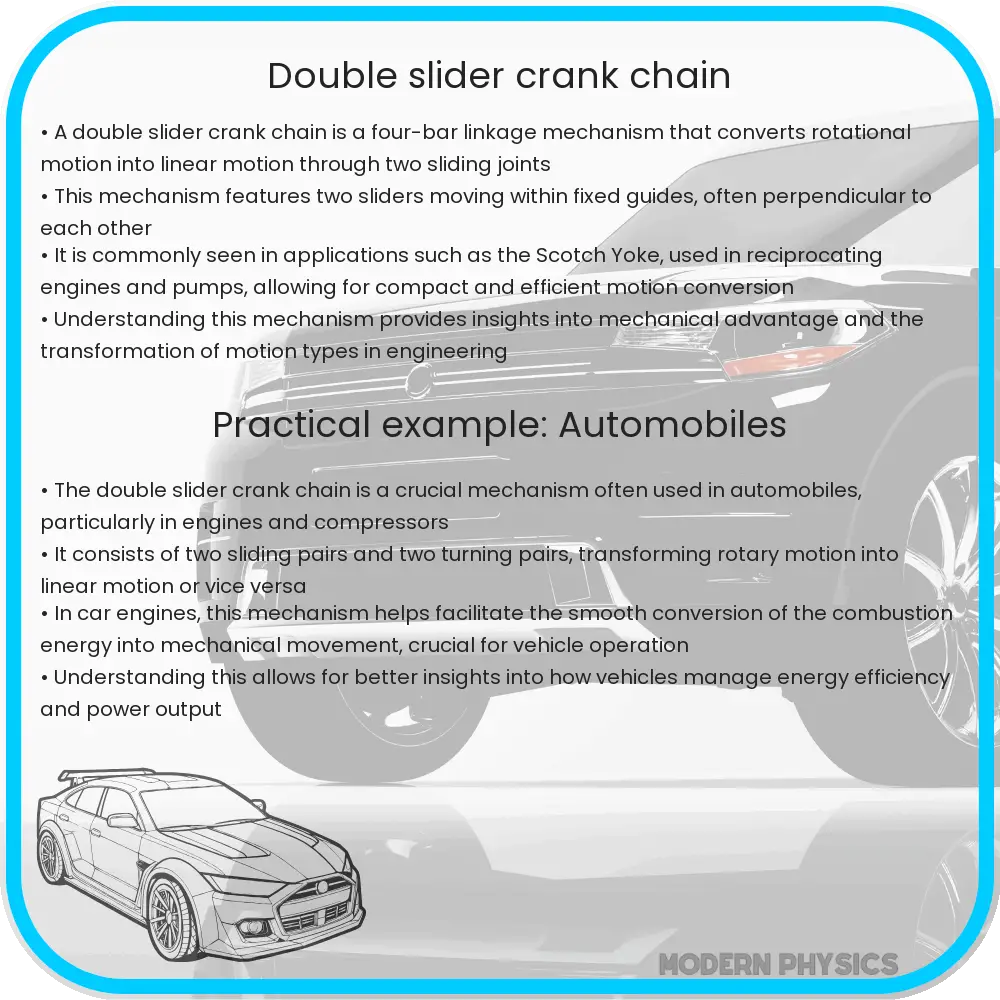Explore the mechanics and applications of the Double Slider Crank Chain, a key mechanism in engineering for converting motion, with future insights.

Understanding the Double Slider Crank Chain Mechanism
The Double Slider Crank Chain is a complex yet intriguing mechanical assembly used in various applications across engineering and mechanics. Its fundamental design consists of two sliding elements (sliders) connected by a crank and a connecting rod. This setup allows the conversion of rotational motion into linear motion, or vice versa, making it a critical component in many machinery and devices.
Mechanics and Motion of the Double Slider Crank Chain
At the heart of the Double Slider Crank Chain’s operation lies the principle of converting rotational motion into linear motion. The crank, typically a rotating disk or arm, connects to a connecting rod. This rod then attaches to the sliders, which move back and forth along a path. The crank’s rotation propels the sliders, translating the circular motion into a straight-line movement. This mechanism is vital in systems where precise linear motion is required.
Dynamics of the System
The dynamics of the Double Slider Crank Chain are governed by Newton’s laws of motion and can be analyzed using various mathematical models. The force exerted by the crank is transmitted through the connecting rod, influencing the sliders’ movement. The efficiency and effectiveness of the mechanism are highly dependent on the dimensions and mass of the components, as well as the friction between the sliders and their paths.
Applications in Modern Engineering
The Double Slider Crank Chain finds extensive applications in modern engineering. One common example is in internal combustion engines, where it translates the linear motion of pistons into the rotational motion of the crankshaft. Another application is in reciprocating compressors, where it helps in the compression and displacement of gases. The simplicity and efficiency of the mechanism make it suitable for a wide range of mechanical devices.
Challenges and Innovations
Despite its widespread use, the Double Slider Crank Chain mechanism faces challenges, particularly in terms of wear and tear due to friction. Innovations in materials science and lubrication technologies are continually being developed to enhance the longevity and efficiency of these systems. Additionally, advancements in computer-aided design (CAD) and simulation tools have significantly improved the precision in the design and analysis of these mechanisms.
Optimizing Performance and Efficiency
To optimize the performance of the Double Slider Crank Chain, several factors need consideration. The selection of materials for the crank, rod, and sliders is crucial, as it determines the system’s durability and resistance to wear. Modern alloys and composite materials offer strength and lightweight properties, enhancing the mechanism’s efficiency. Additionally, the geometric design of the components plays a pivotal role in minimizing friction and maximizing the smoothness of motion.
Mathematical Modeling and Simulation
Mathematical modeling and computer simulations are invaluable tools in the study and improvement of Double Slider Crank Chain mechanisms. By employing sophisticated algorithms and software, engineers can predict the behavior of these systems under various conditions. This approach allows for the optimization of design parameters, such as the length of the crank and connecting rod, and the path of the sliders, ensuring maximum efficiency and performance.
Future Perspectives
The future of Double Slider Crank Chain mechanisms is promising, with continuous advancements in technology paving the way for more innovative applications. One area of potential growth is in robotics and automation, where precision and efficiency of motion are paramount. Moreover, the increasing focus on renewable energy sources may see novel adaptations of this mechanism in devices like wave and wind energy converters.
Conclusion
The Double Slider Crank Chain is a fundamental mechanism in the realm of mechanics and dynamics, offering a versatile solution for converting rotational motion into linear motion and vice versa. Its simplicity, coupled with its efficiency, makes it an indispensable component in various mechanical systems, from engines to automated machinery. With ongoing developments in materials science and computational modeling, the Double Slider Crank Chain continues to evolve, offering enhanced performance and broader applications in modern engineering. The future holds exciting possibilities for this mechanism, as it adapts to the changing needs and challenges of technology and innovation.
